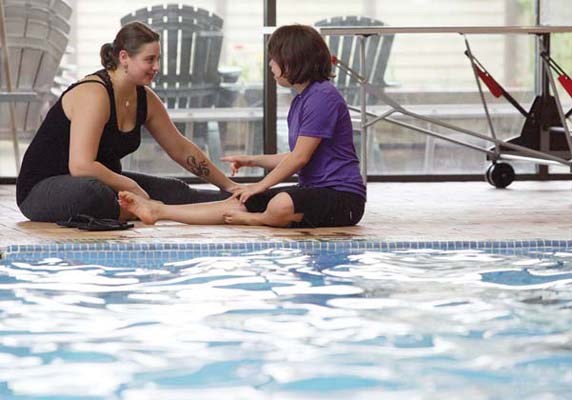At Burnaby Caprice Synchronized Swimming Club it's all about taking a step-by-step approach.
In fact, the club philosophy handed down by late founder, Jean Peters, is an acronym STEPS - Synchronized skill development, Teammwork, Expression through movement and music, Physical fitness and Spirit.
Now, almost 40 years since the club was founded, Caprice is taking another step forward in offering the first adapted synchronized swim program for developmentally challenged swimmers in the Lower Mainland.
Burnaby Mountain student Aliya Dall'Antonia loves the water, and, like her younger sister Lianna, who swims recreationally at Caprice, also enjoys dancing.
So when mother Adrienne approached then Caprice club president Daryl Pflueger with the idea of a special program for her older daughter, she was met with nothing but enthusiasm and support.
"They paired her up with this wonderful teacher. This has been a fabulous fit. Aliya doesn't like to be singled out as special needs. They try lots of new things. They're nothing but encouraging," said Adrienne.
For Caprice coach and swimmer Melinda Markser, it was an equally perfect fit.
"I responded immediately," said the 23-year-old Markser, who is in her sixth year as coach and eighth as a swimmer at Caprice. "I'm going to school for theraputic recreation and it was right up my alley."
Although Markser had completed her diploma in TE at Douglas College this year, there was no real template available to build an adapted sychronized swim program.
She gained some experience volunteering in the City of Vancouver's adapted programs, but is largely building her own lesson plans based on the club's star manual as she herself learns.
"There is a lot of positive feedback and a lot of high fives," said Markser, who joins Aliya in the water during practices. "I explain first, then arrange her arms and fingers to show the proper positioning and try to move her physically. I teach my older girls like that as well, to get that feeling so they know if it was right or wrong."
The only blip occurred when Aliya was scheduled an early weekday evening class and appeared unmotivated.
The club changed the time to a Saturday morning spot and that seemed to make all the difference.
"It was like night and day in her willingness to try new things," said Adrienne. "She's working up to figures. She's always had flexibility, she just needs to work on strength."
After that, Aliya proved a fast learner and the two moved through the basics quickly.
By next season, the pair would like to move on to developing a routine that can be performed.
The idea of matching Aliya with a partner one day is also a goal still yet to be achieved.
To that end, Markser is planning to approach organizations like Developmental Disabilities Association and the Burnaby Association for Community Inclusion, who may have clients who would like to give sychronized swimming a try.
Markser says she has seen first-hand how sychronized swimming changes a girl for the better.
"The older girls have changed dramatically and not just in their (swimming) ability, but psychologically. They have become stronger. They are more assertive and comfortable in themselves. I believe it will have the same effect on a child with a disability. They would continue to train and grow. It's about, 'I can do this.' I've seen it," Markser said.
From a parent's point of view, the program is achieving most of of the expectations Adrienne had for her daughter, as well.
"From my perspective, it's exercise, it helps (girls) become more comfortable with their bodies, they learn safety around water, to be part of a club. Plus, it's a whole different group of kids, which leads to gaining further acceptance in the community," said Adrienne.
But perhaps best of all, it's how Aliya feels about the interpretive sport.
"It's really fun," Aliya said. "(Melinda) is really good. She's fun and she's nice.
"It's so different because when I get into the water, it's so cool and clear. - I have my goggles on and I have to hold my breath. I feel like a mermaid. Under the water is really fun. It's so pretty and blue underneath."



